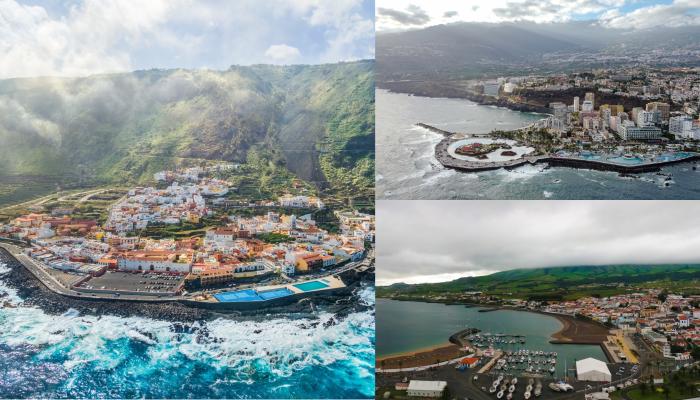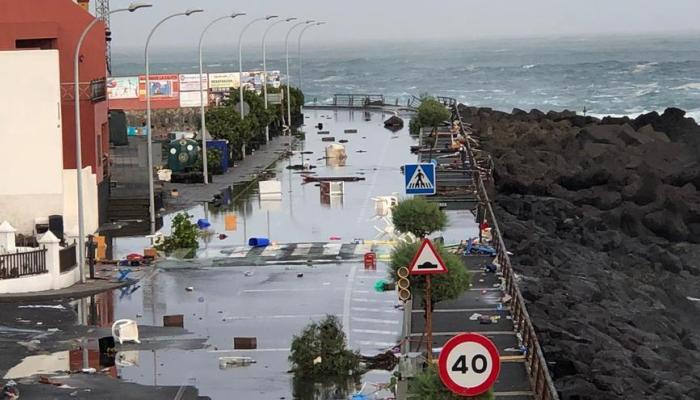
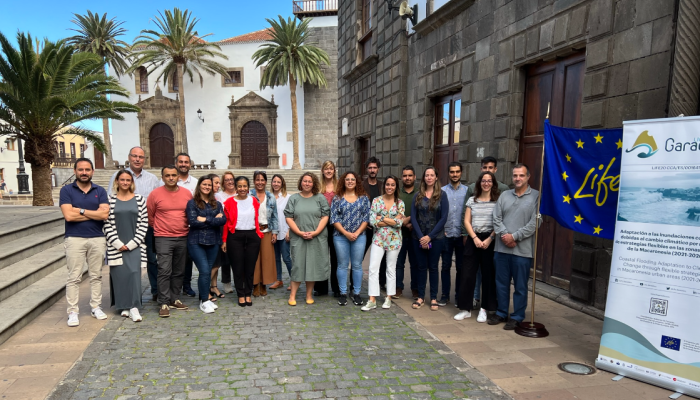
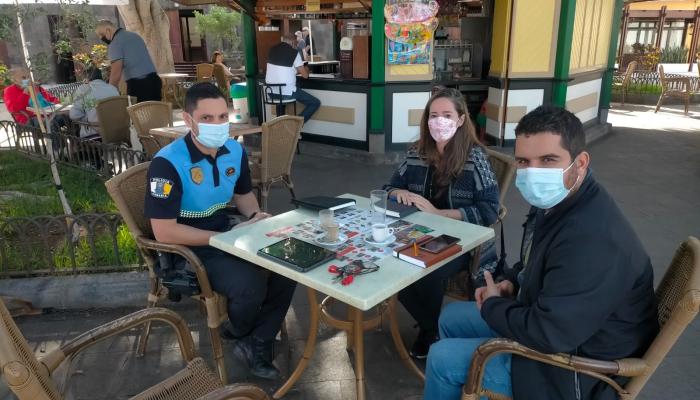
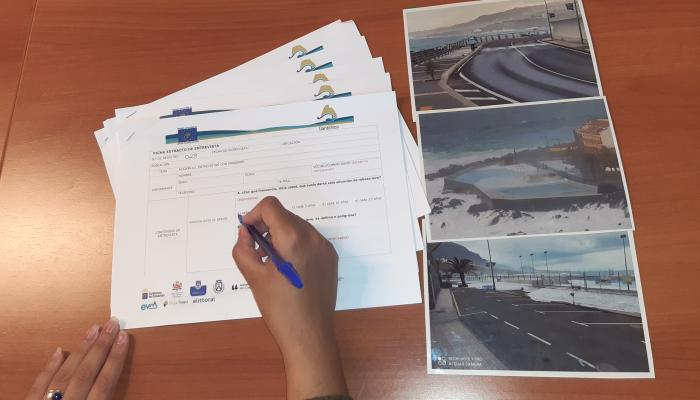
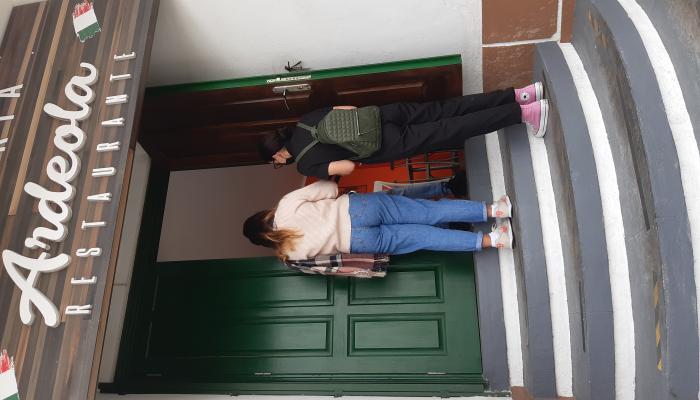
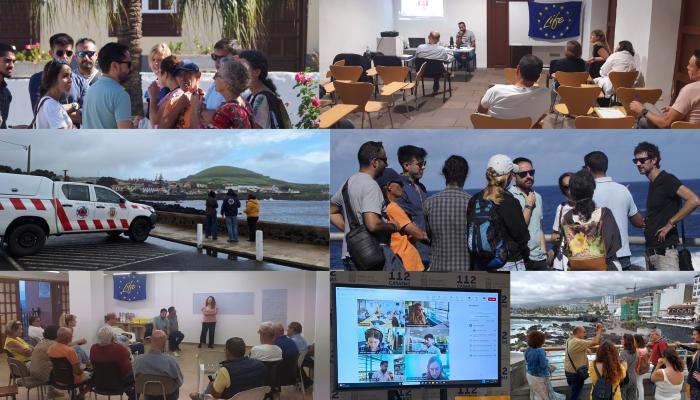
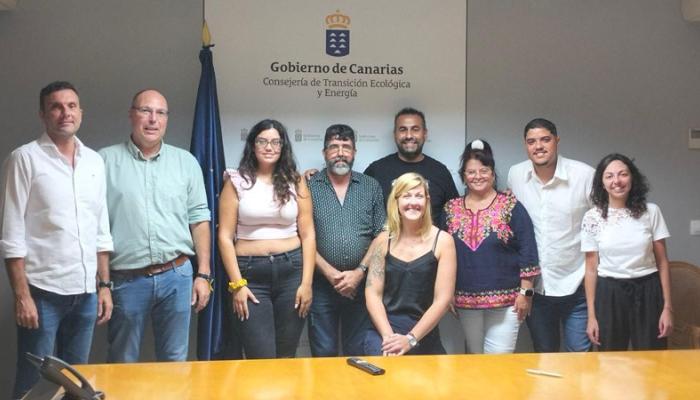
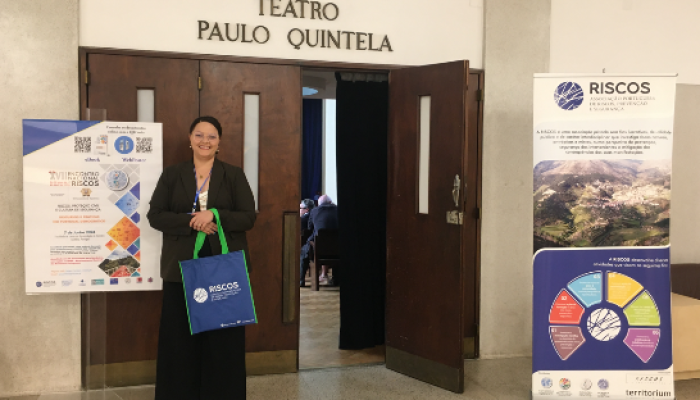

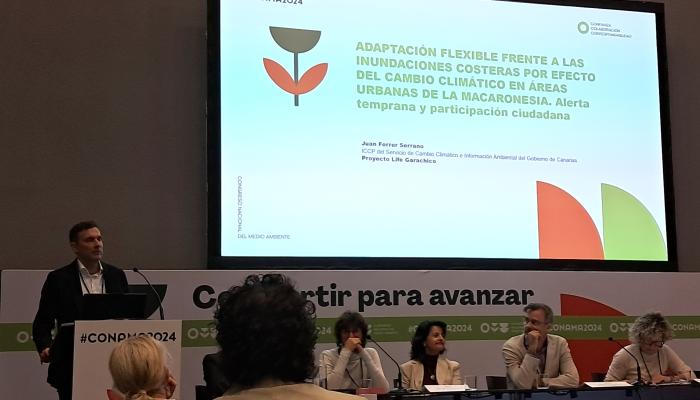
The coastal urban areas of Macaronesia are particularly vulnerable to Climate Change (CC) due to rising sea levels and the increased frequency and intensity of adverse weather events. This situation is aggravated by the local orography and its exposure to Atlantic storms, causing significant damage in populated areas.
Traditional solutions based on rigid structures are not recommended for Macaronesia, as their rigidity limits dynamic adaptation to the changing climate and can harm tourist attractions, environmental values, and cultural heritage.
In this context, the LIFE GARAHICO project proposes a flexible strategic adaptation framework for flood risk reduction, based on acceptable risk levels for society, and focused on guaranteeing citizen safety and the reduction in economic losses caused by these phenomena. This approach contemplates adaptive measures that evolve and adjust according to changing conditions, thus increasing resilience to floods and significantly reducing the negative impacts of these extreme events.
Within the framework of the European Union, coastal areas are home to about 200 million inhabitants (more than a third of its population). This, together with the predictions of sea level rise by CC, whose models predict increases of up to 0.54 m for the RCP 2.6 scenario and 0.81 m for the RCP 8.5 scenario by 2100 in these regions, reflects the importance of undertaking policies that reduce the impact of coastal flooding in various areas. [IPCC, 2014]
Within the framework of the European Union, coastal areas are home to about 200 million inhabitants (more than a third of its population). This, together with the predictions of sea level rise by CC, whose models predict increases of up to 0.54 m for the RCP 2.6 scenario and 0.81 m for the RCP 8.5 scenario by 2100 in these regions, reflects the importance of undertaking policies that reduce the impact of coastal flooding in various areas. [IPCC, 2014]
Thus, in recent years, economic losses due to climatic events in the EU have increased, ranging from 4,500 million euros per year in 1980 to 8,200 million euros in 2013, due to extreme weather and hydrological events [NatCatSERVICE], of which 20% are caused by coastal flooding [Ciscar, 2018].
In the last 20 years, losses in Spain and Portugal (countries to which the project areas belong) have amounted to almost €40,000 million (with only 10% of the damaged property insured). In the specific scope of this project, the municipality of Garachico, in the last decade, has invested an average of € 50,000 per year in repairs of urban furniture and infrastructures due to extreme coastal flooding events.
The use of conventional static techniques is not appropriate in this case due to the Macaronesia region's waterfront characteristics. Firstly, the high degree of confinement of urban settlements in the territory caused by an abrupt orography implements conventional measures unfeasible due to the high investment required. On the other hand, these methods do not work with the treatment of uncertainties, being inconsistent with the fact that the evolution of sea level rise and the increase in frequency and magnitude of extreme events are phenomena of high non-linearity and with dynamic evolution perspectives.
Therefore, it is urgent to manage coastal areas with strategies that allow adjustments in adaptation measures before the occurrence of events with risk of impact on the various goods and socioeconomic agents. In this context, this project seeks to develop an integrated framework for planning, through the implementation of a flexible adaptation strategy, which allows uncertainty to be considered dynamically.
The general objective of the LIFE Garachico project is to develop and implement a Strategic Framework for Flexible Adaptation (MEAF) for urban coastal areas subject to flooding based on the levels of flood risk acceptable to society and on the implementation of a series of adaptation measures to increase these areas' resilience.In order to achieve this general objective, six specific objectives are developed:
The general objective of the LIFE Garachico project is to develop and implement a Strategic Framework for Flexible Adaptation (MEAF) for urban coastal areas subject to flooding based on the levels of flood risk acceptable to society and on the implementation of a series of adaptation measures to increase these areas' resilience.In order to achieve this general objective, six specific objectives are developed:
1. Standardize a procedure for analyzing coastal flood risk due to Climate Change in urban areas in an HFSM.
2. Provide tools to determine the acceptable risk levels of urban communities.
3. Implement in Garachico and replicate in Praia da Vitória and Puerto de la Cruz adaptation measures that, together with early warning systems, reduce risk and increase resilience
4. Develop technical recommendations and management tools in an NAFM to reduce flood risk and for their implementation in Macaronesia
5. Develop new management policies and market products in conjunction with the various stakeholders to manage remaining risk and increase employability
6. Promote the implementation of the MEAF in other vulnerable coastal urban areas of the EU.
The LIFE Garachico project implements two packages of measures to adapt to coastal flood zones.
On the one hand, the so-called soft measures, which are made up of:
1. Early Warning System (SAT). For the project, a SAT is fully developed that sends flood alert warnings to the main regional, island and municipal risk agents, 72 hours in advance. In this way, specific action protocols can be activated in the event of flooding to prepare the municipality by mitigating its impacts
2. Action protocols for the access and circulation of urban traffic (light and heavy) and pedestrian access to the promenade. These protocols have a diversion of urban traffic through secondary roads, avoiding circulation through the municipality of Garachico. This is because the main island road that connects the Icod-Daute-Isla Baja region more efficiently with the north of Tenerife passes along the coast of Garachico and is usually affected by the waves, causing it to be closed for days. Until now, the detour of that road was made inside the urban area of Garachico itself, declared an Asset of Cultural Interest, causing wear and tear and large traffic jams. As for the protocols for pedestrians, they restrict pedestrian access to the areas of the municipality affected by the action of the waves. Specifically, access to the general island road on the coast is prohibited, while the rest of the areas are monitored to carry out closure actions, if necessary
3. Maintenance of the municipality's waterfront. This measure promotes a municipal policy to avoid the presence of mobile objects (benches, litter bins, etc.) along the waterfront. Overbearing waves can easily carry these objects, greatly increasing the risk of damage and death.
The above points have been developed and drafted in a Municipal Operational Strategic Plan for Coastal Phenomena (PEFOC) with a link to the Municipal Emergency Plan (PEMU) of the municipality of Garachico.
4. Social participation. Participatory actions and questionnaires are carried out to work and involve the neighbours, which will allow them to: I) know the risk of coastal flooding, II) create a space for meeting and communication, to share and discuss adaptation measures.
5. Creation of Safe Wave Observation Points, which are located outside the risk areas and the passage of emergency work. Its purpose is to bring together tourists and citizens who seek to observe these major flood events, guaranteeing their safety.
On the other hand, we have the so-called hard measures, which are construction measures specifically designed for the Garachico area, composed of:
1. Anti-impact benches. Benches will be installed in the areas most affected by the overto-run, in order to serve as anti-wave impact elements with buildings and street furniture.
2. Drainage system. A drainage system will be installed to evacuate the water from the overflow of the waves on the promenade, in order to reduce the effect of its impact on the buildings. The system will return the water to the sea through a point placed at a lower level.
3. Elimination of parking on the maritime avenue. Light vehicle parking will be eliminated in order to reduce the risk caused by extreme flooding events and expand the area available for the population and tourism. Likewise, this expansion of the sidewalk will house the drainage system and the anti-impact blocks.
The effectiveness of the measures implemented will be analysed to find out how much they reduce flood risk, both the real risk and the risk perceived by society.
On another point, insurance will be promoted and the feasibility of creating resilience funds will be explored, which will guarantee insurance coverage against damage caused by coastal flood events for those who cannot afford to pay basic insurance, acting as a social shield to protect the most disadvantaged population sectors of the target community from these impacts. In addition, resilience funds will allow future flexible adaptation measures to be financed efficiently.
Finally, a Regional Platform will be created, coinciding with the proposal in Law 6/2022, of 27 December, on Climate Change and Energy Transition in the Canary Islands, which will aim to share information and experiences through co-creation events, as well as to study the feasibility of replicating the project in other coastal areas that present the same vulnerability.
In the LIFE Garachico project, adaptation to Climate Change plays a fundamental role.
In the LIFE Garachico project, adaptation to Climate Change plays a fundamental role.
To this end, the measures that are developed during the project, specific to the municipality of Garachico, will be implemented, which seek to improve:
On the one hand, the capacity to respond to the emergency in the face of these flood events, improving citizen safety
On the other hand, to reduce the economic losses resulting from these events for both public and private properties, and both for the business fabric and for citizens in general
With the above, the resilience of these areas, vulnerable to coastal flooding events, will increase, adapting them not only to present scenarios but also to the probable scenarios of the future by CC
The LIFE Garachico project was devised by the Area of Ecological Transition, Fight against Climate Change and Energy of the Government of the Canary Islands, being the current leader of the project, and drafted with the help of technical experts from the Foundation Institute of Environmental Hydraulics of Cantabria (FIHAC), the University of La Laguna (ULL), Cartográfica de Canarias, S.A. (GRAFCAN) and Empresa de Transformación Agraria S.A., S.M.E., M.P. (TRAGSA).
All the partners, a total of 11 entities that make up the consortium, participate directly in the development of the project through specific technical actions and dissemination of information.
The LIFE Garachico project has already participated in the public sector, where the population has been able to learn about and participate in the project. In addition, the first technical meeting was held where the flexible adaptation plans for coastal flood risk and the particular methodological framework of this project were shared. Finally, a round table was held on the advantages and limitations of flexible adaptation measures and their application in coastal areas.
The LIFE Garachico project is innovative for developing and implementing for the first time in a coastal urban environment the so-called Strategic Framework for Flexible Adaptation (MEAF), which presents a comprehensive and multidisciplinary approach with which the actions implemented will be continuously monitored, thus evaluating their effectiveness in changing environments such as CC and society.
The LIFE Garachico project is innovative for developing and implementing for the first time in a coastal urban environment the so-called Strategic Framework for Flexible Adaptation (MEAF), which presents a comprehensive and multidisciplinary approach with which the actions implemented will be continuously monitored, thus evaluating their effectiveness in changing environments such as CC and society.
Among the most original measures we can highlight the following:
Social participation: This comprehensive approach contemplates having a high level of social participation throughout the development of the project, thus knowing, on the one hand, with what level of risk perception the project begins on the part of the population, to also be able to assess whether this perception decreases once all the measures are implemented, and on the other, if the resident and working population of Garachico accepts the proposed measures. The aim is to ensure that the measures implemented are adjusted as much as possible to the real needs of society. In addition, they will be provided with the necessary information to help them live with these flood events safely, such as knowledge of the action protocols or self-protection measures they may use, as well as the importance of taking out insurance that covers the risks of these events.
Early Warning System: Another of the measures developed is the implementation of an early warning system for coastal flood risk. This will give the agents responsible for the risk the ability to make decisions with sufficient time in advance to avoid major damage to the population and infrastructure. Anti-impact benches: Laboratory tests have assessed the effectiveness of the installation of these anti-impact benches against waves for the protection of the infrastructures closest to the coastline.
LIFE Garachico is already replicating the early warning system in other places; one of them is Puerto de la Cruz also in Tenerife, another area seriously affected by coastal flooding on the island. And in Praia da Vitória, on the island of Terceira, Azores, with the aim of demonstrating that the techniques used can be replicated in different socioeconomic, cultural, territorial and legal circumstances.
The main obstacles that have arisen during the development of the project have been flooding events during the first three years of the project, which has made it impossible to corroborate the complete reliability of the system until then, and the bureaucratic procedures that have been needed to carry out some of the actions, which have taken longer than estimated.
The total budget of the LIFE Garachico project is €2,638,132, of which 55% is co-financed by the European Union. The remaining amount, €1,187,163, is contributed by the Associate Beneficiaries of the project itself, being approximately €737,000 from local, island and regional public administrations, and the rest from private capital.
- The LIFE Garachico project has been the legislative framework of recent years a European level. As an example, we can take the new Climate Change Law of Spain (the country where the pilot location is located), whose Article 18 pursues the objectives of ''increasing the resilience of the Spanish coast to CC'' and ''integrating adaptation to climate change into coastal planning and management'', adding Article 19 that this integration of management and planning must ''promote progressive adaptation and resilience to CC''. This type of flexible adaptation strategies has not been applied in the framework of coastal flood adaptation in the EU, nor has any methodological framework been developed for their application in urban coastal areas considering the multidimensionality of the risk.
The project has a duration of 5 years, starting on September 21, 2021, and ending on September 21, 2026
www.lifegarachico.eu
IPCC, 2014: Climate Change 2014: Impacts, Adaptation and Vulnerability. Summaries, FAQs, and multi-chapter boxes. Contribution of Working Group II to the Fifth Assessment Report of the Intergovernmental Panel on Climate Change [Field, C.B., V.R. Barros, D.J. Dokken, K.J. Mach, M.D. Mastrandrea, T.E. Bilir, M. Chatterjee, K.L. Ebi, Y.O. Estrada, R.C. Genova, B. Girma, E.S. Kissel, A.N. Levy, S. MacCracken, P.R. Mastrandrea and L.L. White (eds.)]. World Meteorological Organization, Geneva, Switzerland, 200 pp. (in Arabic, Chinese, English, French, Russian and Spanish )
Ministry of Agriculture, Food and Environment (2014). Climate Change on the Spanish coast. Government of Spain
European Commission (2013). Proposal for a Regulation of the European Parliament and of the Council on the establishment of a climate and energy framework by 2030 (COM(2013) 216 final
Gustavo Pestana Pérez
Head of the Climate Change and Environmental Information Service
Vice-Ministry of Ecological Transition, Fight against Climate Change and Energy of the Government of the Canary Islands
Phone: 922922234
Email: gpesper@gobiernodecanarias.org
Saray Pérez de la Rosa
Technical Coordinator of the LIFE GARACHICO Project
TRAGSA Group
Phone: 610594178
Email: sperez14@tragsa.es



